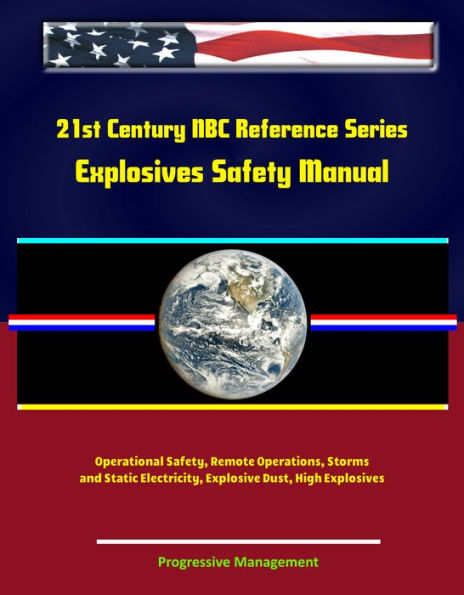This document has been produced by the U.S. Department of Energy, Office of Worker Safety and Health, with special reference to the Pantex facility in Texas which handles nuclear weapons. The introduction states: "This updated version that includes all changes as approved by the DOE Explosives Safety Committee and is intended for Pantex use. It provides Pantex personnel with one reference for the latest requirements [and] is approved for use at Pantex Plant. This document represents the up-to-date version of the DOE Explosives Safety Manual."
"SCOPE, PURPOSE, AND JUSTIFICATION - This Manual prescribes the Department of Energy (DOE) safety standards and procedures used to implement the DOE safety policy for operations involving explosives, pyrotechnics, and propellants, or assemblies containing these materials. With the exception of on-site explosives storage and transportation, this Manual does not apply to commercial activities such as routine construction or routine tunnel blasting. Explosives handling and processing operations by the DOE are an integral part of DOE weapons and weapons-related development, manufacturing, and dismantlement activities. Safety in all operations associated with weapons development is an ongoing, prime concern and must continually be given high priority in all program direction and management. This Manual provides uniform guidance for all DOE facilities and installations involved in explosives handling or processing."
"Maintaining explosives safety in all operations within DOE is an ongoing process that, to be truly effective, must be given high priority in all program direction, management, and line activities. Due to the unique nature of DOE’s highly active role in research and development in new explosives formulations, explosives synthesis, charge geometry, and explosives assemblies, as well as the proximity of explosives to weapon components, it is necessary to maintain the level of explosives safety standards commensurate with the risks. This Manual closes the considerable safety gap created by DOE’s unique activities by establishing safety controls not found in existing DOE or non-DOE regulations to govern the DOE explosives safety process and ensure that explosives safety is commensurate with the actual risk."
Contents include:
* Definitions
* Operational Safety
* Remote Operations
* General Explosives Area Controls
* Electrical Storms and Lightning Protection
* Static Electricity
* Explosive Dust Exhaust Ventilation
* Storage Compatibility Groups for Explosives and Explosive-Containing Devices
* High Explosives
This document has been produced by the U.S. Department of Energy, Office of Worker Safety and Health, with special reference to the Pantex facility in Texas which handles nuclear weapons. The introduction states: "This updated version that includes all changes as approved by the DOE Explosives Safety Committee and is intended for Pantex use. It provides Pantex personnel with one reference for the latest requirements [and] is approved for use at Pantex Plant. This document represents the up-to-date version of the DOE Explosives Safety Manual."
"SCOPE, PURPOSE, AND JUSTIFICATION - This Manual prescribes the Department of Energy (DOE) safety standards and procedures used to implement the DOE safety policy for operations involving explosives, pyrotechnics, and propellants, or assemblies containing these materials. With the exception of on-site explosives storage and transportation, this Manual does not apply to commercial activities such as routine construction or routine tunnel blasting. Explosives handling and processing operations by the DOE are an integral part of DOE weapons and weapons-related development, manufacturing, and dismantlement activities. Safety in all operations associated with weapons development is an ongoing, prime concern and must continually be given high priority in all program direction and management. This Manual provides uniform guidance for all DOE facilities and installations involved in explosives handling or processing."
"Maintaining explosives safety in all operations within DOE is an ongoing process that, to be truly effective, must be given high priority in all program direction, management, and line activities. Due to the unique nature of DOE’s highly active role in research and development in new explosives formulations, explosives synthesis, charge geometry, and explosives assemblies, as well as the proximity of explosives to weapon components, it is necessary to maintain the level of explosives safety standards commensurate with the risks. This Manual closes the considerable safety gap created by DOE’s unique activities by establishing safety controls not found in existing DOE or non-DOE regulations to govern the DOE explosives safety process and ensure that explosives safety is commensurate with the actual risk."
Contents include:
* Definitions
* Operational Safety
* Remote Operations
* General Explosives Area Controls
* Electrical Storms and Lightning Protection
* Static Electricity
* Explosive Dust Exhaust Ventilation
* Storage Compatibility Groups for Explosives and Explosive-Containing Devices
* High Explosives

21st Century NBC Reference Series: Explosives Safety Manual - Operational Safety, Remote Operations, Storms and Static Electricity, Explosive Dust, High Explosives

21st Century NBC Reference Series: Explosives Safety Manual - Operational Safety, Remote Operations, Storms and Static Electricity, Explosive Dust, High Explosives

Product Details
| BN ID: | 2940011291692 |
|---|---|
| Publisher: | Progressive Management |
| Publication date: | 05/07/2011 |
| Sold by: | Smashwords |
| Format: | eBook |
| File size: | 251 KB |
